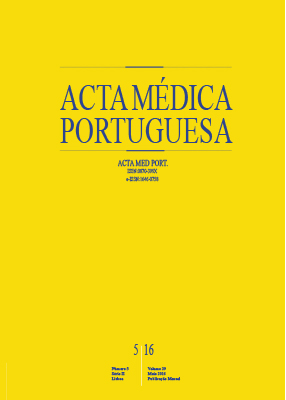Endovascular Treatment of Aortic Aneurysms and Blood Transfusion. What do We Need?
DOI:
https://doi.org/10.20344/amp.7283Keywords:
Aortic Aneurysm/surgery, Blood Transfusion, Clinical Protocols, Endovascular Procedures.Abstract
Introduction: Comparatively to open repair, endovascular aneurysm repair has reduced transfusion rates but there’s no recommendation about number of red blood cells units to be crossmatched preoperatively. Our aim is contribute to the analysis of red blood cells units needs in endovascular and hybrid aortic aneurysm repair and developing a protocol for maximum surgical blood orders schedule.
Material and Methods: We retrospectively analyzed our prospective database of elective endovascular aneurysm repair from 2001 to 2012. We analyzed patients’ age, gender, ASA classification, maximum surgical blood orders schedule, red blood cells units transfused and timings, types of endoprosthesis, red blood cells units consumption/endoprosthesis’ type ratio, crossmatch to transfusion ratio, conversion to open repair, hemoglobin concentrations before surgery and discharge.
Results: We selected 187 patients, 90% men, mean age 73.1, ASA mode III. The endoprosthesis were aorto-bi-iliac in 71%, aorto-uni-iliac in 23% and thoracic in 6%. Of these, 72,6% of the patients did not require blood transfusion. We transfused 171 red blood cells units. Crossmatch to transfusion ratio was 10.1 until 2010 and 7.3 after. The ratio of red blood cells units consumption/endoprosthesis in the first 24 hours was 0.21 red blood cells units/aorto-bi-iliac, 0.46 red blood cells units/aorto-uni-iliac, 0.8 red blood cells units/thoracic, 1.3 red blood cells units/hybrid-thoracic and 2 red blood cells units/hybrid-aorto-bi-iliac. A statistical correlation was observed between red blood cells units transfused postoperatively and type of endoprosthesis (p < 0.001) and between ASA classification and red blood cells units transfused after 24 hours (p < 0.01).
Discussion: Guidelines from the British Society of Haematology are based on a crossmatch to transfusion ratio of 2:1. Our crossmatch to transfusion ratio was 10.1 until 2010 and 7.3 from 2011 to 2012.
Conclusion: These results changed our policy of maximum surgical blood orders schedule for endovascular aneurysm repair. We now type and screen aorto-bi-iliac and aorto-uni-iliac. We crossmatch two red blood cells units for thoracic, three red blood cells units for hybrid thoracic and four red blood cells units for hybrid abdominal procedures. This may lead to financial savings, improved efficiency and reduce workload in hematology department.
Downloads
Downloads
Published
How to Cite
Issue
Section
License
All the articles published in the AMP are open access and comply with the requirements of funding agencies or academic institutions. The AMP is governed by the terms of the Creative Commons ‘Attribution – Non-Commercial Use - (CC-BY-NC)’ license, regarding the use by third parties.
It is the author’s responsibility to obtain approval for the reproduction of figures, tables, etc. from other publications.
Upon acceptance of an article for publication, the authors will be asked to complete the ICMJE “Copyright Liability and Copyright Sharing Statement “(http://www.actamedicaportuguesa.com/info/AMP-NormasPublicacao.pdf) and the “Declaration of Potential Conflicts of Interest” (http:// www.icmje.org/conflicts-of-interest). An e-mail will be sent to the corresponding author to acknowledge receipt of the manuscript.
After publication, the authors are authorised to make their articles available in repositories of their institutions of origin, as long as they always mention where they were published and according to the Creative Commons license.









